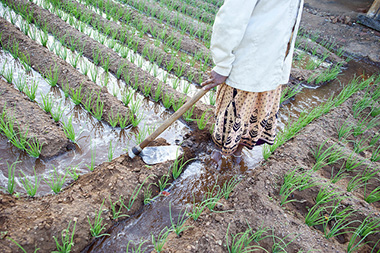The following story was originally published on the CGIAR Research Program on Water, Land, and Ecosystems (WLE) Thrive Blog.
Water management challenges are closely linked to many of the Sustainable Development Goals, especially those relating to poverty reduction, food security and nutrition, and environmental sustainability. Proper water management is a particularly tricky balancing act to achieve. There must be sufficient access to clean and safe water for consumption, sanitation, and agriculture, while communities must have enough infrastructure in place to control flooding amongst other disaster-risk management. Too little and we have a problem, too much, and again, it’s a problem: this is a Goldilocks dilemma.
Investment in new infrastructure and technologies can increase water access and control by balancing out under or over supply. But the appropriate institutions and supportive policies must be in place for these investments to benefit all water users.
I attended the 2015 Dupont Summit in which a panel discussed this confluence of technologies, policies and institutions in agricultural water management. The panel presented recent research on this complex topic, in South Asia and sub-Saharan Africa, with presentations from Meredith Giordano, Simone Passarelli, Marco Janssen and myself, Claudia Ringler.
Here’s a recap of our presentations:
Meredith Giordano: Unlocking the potential for smallholder agriculture in sub-Saharan Africa and South Asia
Giordano’s presentation describes the livelihood benefits from small-scale irrigation technologies in sub-Saharan Africa and South Asia. In Africa, water management by smallholder farmers has often greater impact than that of the public irrigation sector, covers more land area, serves more people and generates more income. However, the unregulated spread of private irrigation poses such risks as over-abstraction, pollution, conflicts, and can limit the access of women and resource-poor farmers.
Simone Passarelli: Tapping irrigation’s potential for women’s empowerment
Passarelli’s presentation lays out the potential of irrigation technologies to go beyond growing crop yields to enhancing the nutritional and other health outcomes for farm families and communities in Ethiopia and Tanzania. This could best be achieved with the production of more nutritious crops, the improved decision-making power of women and the complementary use of irrigation water for other household needs. To support nutrition-smart irrigation would require breaking down silos between national and district agencies for agriculture, water and health.
Marco Janssen: Building institutions for groundwater governance in Andhra Pradesh, India
In South Asia, over-extraction of groundwater is now a key water challenge due to widely available, affordable technologies as well as poor pricing and regulation. Janssen’s presentation describes a promising tool—experimental games—to enhance understanding of the impacts of irrigation on groundwater levels while also strengthening joint management of shared groundwater resources.
Claudia Ringler: Assessing Models of Public Private Partnership in Irrigation Development
Finally, my presentation cautions that public-private partnerships (PPPs), designed to mobilize investment and accelerate irrigation development in Africa, are not necessarily panaceas. Key challenges that need to be considered when developing PPPs include:
- difficulty in aligning private-sector profit and government development objectives (with the private sector often preferring cash crops while government entities prefer food crops)
- the need for information on water availability, particularly under climate change and with competing uses
- insufficient attention of PPP development to training needs and input and output markets for commercial PPP production
- lack of consideration of land and water rights; and, most importantly
- the exclusion of the investors with most at stake—farmers—at the negotiation table.
So what would Goldilocks look for?
Although, there is no unique recipe for success, these four presentations begin to weigh the complex benefits and risks of agricultural water management in sub-Saharan Africa and South Asia. The discussion addressed how policies, institutions, and technologies in agricultural water management are interrelated and thrive upon each other, and must be utilized in such manner so that all three work together, with balance across all three, to achieve holistic water management solutions. It is vital that we acknowledge this in future agricultural water management activities that are slated to increase under growing climate change and variability.
The future of farmers depends on it.







